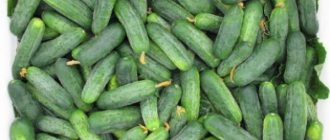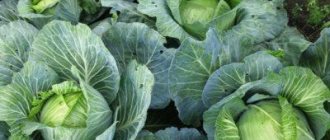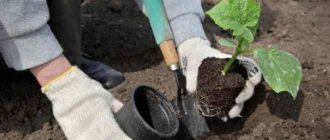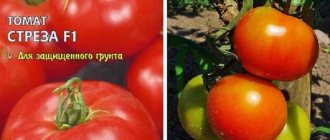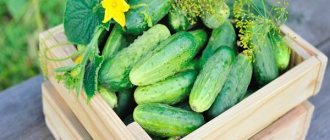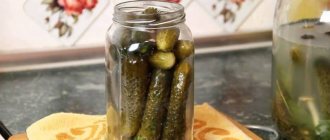Description of the variety
The bushes are medium-sized, well-leafed with light green and green leaves. The plant is medium-climbing, with at least two ovaries formed at each node. The hybrid is parthenocarpic and early ripening, so high yield occurs 43-45 days after germination.
The harvested crop can be used both fresh and for canning. The hybrid form has sufficient disease resistance and is resistant to cladosporiosis. It is characterized by relative resistance to powdery mildew and cucumber mosaic virus.
The length of greens can be 6-9 cm, the surface is coarsely tuberous. The fruits are cylindrical in shape, weighing from 67 to 120 g. The pulp is very tender and tasty, without voids or bitterness. The total yield, subject to agricultural technology and favorable weather conditions, reaches 12-15 kg per square meter.
Diseases and pests
The Pasamonte variety resists powdery mildew, cucumber mosaic virus, brown spot, but is not resistant to diseases and pests such as:
- whiteflies - insects that feed on plant sap, cause great damage to the crop, as a result of which cucumber bushes weaken and dry out. You can fight them with the help of garlic tincture (pour 100 g of chopped garlic into 0.5 liters of water, leave for 5 days, dilute in water in a ratio of 5 g of tincture per 1 liter of water), Actellik preparations (2 ml per 2 liters of water) , “Fufanon” (5 ml per 5 liters of water), “Confidor” (1 g per 10 liters of water), etc.;
- root-knot nematodes are pests that devour the root part of the plant and destroy large quantities of the crop. In preventative measures, you need to adhere to crop rotation, dig up the soil, and burn affected plants. Chemical agents that counteract nematodes include: “Metarizin” (500 ml per 10 liters of water), “Fitohit”, “Pecilomycin”;
- downy mildew is a fungal disease that occurs in the form of light spots appearing on leaves or stems, which darken over time, resulting in the death of the plant. Greenhouse cucumbers are most often affected. The most effective remedies are “Profit” (6 g per 5–10 l of water) and “Ridomil Gold” (25 g per 5–6 l of water), you can use an infusion of onion peels (pour 250–300 g of onion peel into 10 l of water, infuse 2–3 days);
- bacteriosis is a disease that develops during high air humidity and leads to rotting of bushes. Can completely destroy the entire crop. To avoid this, it is necessary to regularly ventilate greenhouses, loosen the soil, and prevent it from becoming waterlogged. You can also use the preparations “Ridomil Gold”, “Metaxil” (25 g per 5 l of water), “Etafol” - (10–20 g per 10 l of water);
- gray rot - affects the plant and fruits of cucumbers in the form of a gray coating, which leads to rotting and death of the bushes. Effective methods of control are Bordeaux mixture (20 g per 5 l of water), a solution of chalk and water (1:1 ratio), the drug "Rovral" (1% solution), "Hom" (40 g per 10 l of water), "Bayleton" "(1 g per 1 liter of water).
Advantages and disadvantages
An early-ripening parthenocarpic hybrid of the gherkin type from Dutch selection with a bunched ovary arrangement has a sufficient number of advantages, thanks to which it enjoys increased attention among gardeners and small farmers:
- has complex resistance to major cucumber diseases;
- the hybrid is self-pollinating and does not require insects;
- early ripening and very high-yielding;
- genetically without bitterness, with high taste;
- the ratio of the length of the greenery to its width is 3:1, high color intensity and excellent marketable appearance;
- cultivation for the purpose of producing gherkins;
- possibility of universal use;
- Greens stop growing when they reach optimal size at the stage of harvest maturity.
When cultivating the hybrid form "Pasamonte-f1", it is necessary to take into account the susceptibility to downy mildew.
Harvest and storage
It is very important for the Pasamonte variety to collect cucumbers on time and at least 2 times a week, due to which the quality of the fruit will only increase and the fruiting period will extend. The first harvest can be harvested from cucumber vines 40–42 days after planting the crop in the ground. The shelf life of vegetables is 10 days without loss of nutritional and commercial qualities. It is recommended to keep them in a dry, cool place or in the refrigerator.
Recently, parthenocarpic varieties of cucumbers, including Pasamonte, have become increasingly popular among professional gardeners and beginners. The hybrid is disease-resistant, easy to care for, bears fruit abundantly, cucumbers have a good taste and are widely used in cooking.
Landing rules
For growing cucumbers, areas are allocated that are well lit and warmed by the sun's rays, and are also provided with fertile soil. Further rules for planting hybrid cucumbers are as follows:
- before winter, the soil must be dug up, with the simultaneous application of manure and basic mineral fertilizers;
- Before planting in open ground, the seed material is heated and necessarily treated with special compounds;
- sowing cucumber seeds directly into the garden bed or planting pre-grown seedlings, but not before warming the soil and air to optimal temperatures;
- the best time for planting cucumbers in the ground is the last days of May, when night temperatures no longer fall below 15-17 °C;
- standard sowing and planting scheme: no more than 3-5 plants per square meter or 20x100 cm, sowing depth 1.5-2.0 cm;
- During planting, seedlings should have 3-4 true leaves, that is, the age of the cucumbers should be at least 2-3 weeks.
It is recommended to provide crops or planted plants with protection from cold weather during the first days, using film cover and standard arcs. You can replace the film with a non-woven covering material that allows light, air and water to pass through, but effectively protects plants from low temperatures.
History of selection
The Dutch hybrid Pasamonte f1 was bred by breeders of the Syngenta seeds company and included in the State Register of Russia in 1997. Approved for cultivation in the Central and Middle Volga regions in open and closed ground.
Plants are medium-sized, medium-climbing. 2-3 greens are formed in one node. The fruits are not prone to overgrowth.
The hybrid belongs to parthenocarpics - plants with a female type of flowering. Male flowers do not take part in fertilization.
Pictured are Pasamonte cucumbers.
Cultivation regions
The hybrid is intended for the following regions:
- Middle Volga;
- Central.
Growing technology
Hybrid early-ripening cucumber "Pasamonte f1" is most often grown on ridges in open ground, so care includes the following measures:
- Watering plants. Before flowering, watering should be moderate, so it is enough to carry out irrigation activities once a week. During the active fruiting phase, watering with warm water is carried out daily or every other day, depending on temperature conditions and soil type.
- Feeding. It should be carried out when flowering appears, using 100% mineral fertilizers or fresh mullein. The variety is responsive to combining watering three times a month with fertilizing based on a liter of manure or 10 g of urea per bucket of warm water.
- Weeding and loosening. To improve the aeration parameters of the soil, it is recommended to regularly carefully loosen the soil or mulch the cucumber beds after weeding.
When growing, you can use both the wings and the trellis method. When grown using a trellis method, denser planting is allowed, but without excessively dense plants. It is recommended to form plants into one stem.
It is very important to carry out timely harvesting of green plants, since their overgrowth shortens the fruiting period and reduces the quality of the fruit.
We also invite you to familiarize yourself with the characteristics and rules for growing cucumbers of the Dolomite f1 variety.
How to grow a hybrid yourself
Pasamonte cucumbers are grown through seedlings and sowing in open ground. Caring for the crop is standard and requires compliance with the watering and fertilizing schedule, loosening and weeding of the area.
Planting by seedlings
The seedling method of growing cucumbers significantly reduces the ripening time. Even in open ground, the harvest begins two weeks earlier compared to cucumbers grown in a greenhouse using direct sowing.
Hybrid seeds do not require pre-sowing disinfection or soaking with growth stimulants. The seed material is processed in production.
To grow strong and healthy seedlings, use nutritious soil: 1 part sawdust, 2 parts peat and humus. Add 2 tbsp to a 10 liter bucket. l. ash and 1.5 tbsp. l. nitrophoska.
The mixture is thoroughly mixed and distributed into plastic or peat containers to the top. Seeds are planted to a depth of 1-2 cm, 1 piece each. into each container and water with warm, settled water.
At the stage of 2-3 true leaves, seedlings are fed with a nutrient solution: 3 tsp. nitrophoska (nitroammofoski) per 3 liters of warm water. Seedlings need to be watered abundantly, once every seven days.
After 27–32 days, the seedlings will be ready to “relocate” to a permanent location.
Holes with a depth of 10-15 cm are formed on the site, boiling water is poured over it and seedlings are planted at a distance of 50–60 cm.
Direct sowing into soil
Cucumbers are hypersensitive to cold, so for rapid germination the soil must warm up to at least +14 °C, and the air - up to +22 °C. The best time for sowing is the last ten days of May. The culture prefers light and nutritious soil from a mixture of turf, sawdust, humus and peat (1:1:1:1).
The site for sowing is chosen on the south side. The soil is dug up before winter, fertilized with humus and watered with a solution of copper sulfate (1 tsp per 3 liters of water). The seeds are planted with the narrow part down, 2 pieces at a time, to a depth of 2-3 cm with an interval of 10 cm. Next, the soil is watered generously with warm, settled water.
The area is covered with polyethylene or agrofibre to protect it from night frosts. The seeds hatch in 6–8 days.
Important! When planting, the main principle of crop rotation is observed - do not grow cucumbers in the same place year after year.
Growing and care
It is not advisable to cultivate cucumber crops near plantings of tomatoes, radishes and radishes. Healthy neighbors are dill, beans, peas, garlic, cabbage, beets, and onions.
Basic rules for successful cucumber farming:
- Loosening the beds after each watering and removing weeds. The procedure is carried out carefully, trying not to catch the roots located close to the surface of the earth.
- Mulching the soil with sawdust or peat will help reduce the amount of weeding.
- Before flowering, moderate watering is provided - once every 7 days. During the fruiting period, plants are watered at the root daily.
- Pruning of the vines is carried out during the period of rapid growth, forming the plant into one stem.
- The culture is responsive to regular feeding. In total, 4-5 portions of fertilizer are applied during the growing season.
Scheme for feeding cucumbers:
- before flowering – 1 tsp. urea and superphosphate, 1 tbsp. l. sodium humate per 10 l;
- during the fruiting period - 1 tbsp. l. nitrophoska, 20 g of chicken manure per 10 liters of water;
- subsequent feedings (every two weeks) – 1 tsp. potassium sulfate, 500 ml mullein per 10 liters of water.
Instead of fertilizers prepared independently, they use ready-made humic fertilizers “Breadwinner”, “Ideal”, “Fertility”.
Features of cultivation and possible difficulties
The agricultural technology of Pasamonte cucumbers does not differ significantly from the cultivation of other hybrids.
Vigorous plants require vertical tying to a trellis.
Cucumbers are planted behind curtain crops (sunflowers, corn) for protection from cold winds and scorching sun rays. Tall crops act as a kind of wall, behind which cucumbers feel comfortable and begin to bear fruit several days earlier.
Reference. Wing crops are sown perpendicular to the direction of the dominant winds 6–10 days before sowing or planting cucumbers.
Diseases and pests
The hybrid is immune to brown spot and cucumber mosaic and is absolutely immune to bacteriosis, powdery mildew, and gray rot of roots.
Treatment of plants with chemicals delays the fruiting of the crop. In the fight against fungi and bacteria, prevention and treatment with organic and mineral compounds are effective.
Signs of powdery mildew:
- white-yellow coating on stems and leaves;
- small brown balls (spores);
- drops of dew on greenery;
- dry leaves, curled upward;
- rot on cucumbers.
Treatment:
- A liter of curdled milk, whey or kefir per 10 liters of water. The number of treatments is not limited.
- Per liter of water 1/3 tsp. soda ash, 25 ml of liquid soap. Treat once every seven days.
- A liter jar of wood ash for 5 liters of boiling water. Leave for 24 hours, spray the bushes once every seven days.
Signs of gray rot:
- gray-brown slippery spots on stems and leaves;
- gray, indefinitely shaped spots on fruits;
- the appearance of watery gray fluff on the fruit.
For safe treatment, use the Trichodermin suspension. For irrigation, 100 ml of the drug is diluted in 10 liters. In case of severe damage, plants are treated up to 5 times a week. To prevent gray rot, before planting in the ground, the roots are dipped in a mixture of 5 liters of water, two parts of soil, one part of humus, 5 g of suspension. After two leaves appear, the seedlings are treated every two weeks.
Signs of bacteriosis:
- yellow-brown spots on cotyledon leaves with a characteristic angular shape;
- mucus from the back of the leaves;
- leaf perforation.
Treatment:
- Infuse 100 g of onion peels in 1 liter of boiling water. After 48 hours, strain the solution and dilute with water in a ratio of 1:5. Treat bushes once every 10 days after sunset.
- For 10 liters of water 1 tsp. boric alcohol and brilliant green, spray the plants once every 20 days.
Disease prevention measures:
- periodic treatment with Trichopolum (2 tablets per 1 liter of water);
- moisture level control;
- compliance with crop rotation;
- removing wilted and dry leaves;
- removing 3–5 cm of soil and removing plant debris at the end of the season;
- timely feeding;
- loosening the soil;
- choosing a sunny place for planting;
- treatment of the plot with "Gamair" before sowing;
- reduction of nitrogen in the soil;
- thinning of plantings.
Spider mites and slugs pose a particular danger to cucumbers. For prevention, the soil is dug up in the fall and left to freeze.
Folk remedies against spider mites:
- grind 1 kg of aloe vera through a meat grinder, pour in 10 liters of water and mix in 50 g of laundry soap shavings;
- pour 300 g of horse sorrel into 10 liters of water, leave for 3–5 hours;
- Pour 50 g of greens and dandelion flowers into 2 liters of water and leave for 3-4 hours.
Processing frequency is once every two weeks.
Folk remedies against slugs:
- Mix equal parts ground black pepper, wood ash and rock salt. Sprinkle the mixture into the beds and loosen.
- Dig furrows around the perimeter of the beds and pour ash and tobacco dust into them in equal parts.
- Mulch the soil with crushed eggshells, pine needles, sawdust, and river sand. Slugs do not like to crawl on such surfaces; sharp particles cut their abdomen.
- Prepare a solution of 1 liter of water and 2 tbsp. l. ammonia. Spray the bushes at night.
Caring for Pasamonte cucumbers
F1 series hybrids have minimal care requirements. However, for high yields, plants should be provided with proper conditions. This variety needs the following:
- watering;
- fertilizer;
- hilling and trimming weaving.
Watering
It is better not to overwater this variety.
The watering regime is regulated depending on the stage of vegetation. Before the formation of flowers, 5 liters of water per 1 m² should be added in case of drought and 2 liters in case of precipitation. During the formation of greens, the plant requires more moisture, so the norm increases to 8 liters in dry weather and 6 liters after rain.
This variety tolerates drought better than excess moisture. Frequent irrigation can lead to rotting of the root system.
Pasamonte cucumbers also experience discomfort when an earthen crust forms after watering. To avoid problems with plant development, you should hill up the area after irrigation. In this case, extreme caution must be taken, since the root system of cucumbers comes close to the surface of the earth. It is also better to water in the morning with warm water, since the variety does not tolerate cold well.
Fertilizer
Organic fertilizers should be used as fertilizer. Some mineral complexes can be prepared at home:
- serum solution with added iodine;
- onion infusion;
- fresh mullein or diluted chicken droppings.
The optimal way to apply fertilizers is to dilute nutrients in water for irrigation. Typically, urea is used as a top dressing for cucumbers in proportions of 10 g per 10 liters of water.
Garter and shaping
Pasamonte cucumber bushes are vigorous, so they need to be tied vertically to a trellis and the plants formed into one stem. After 3–5 true leaves appear on the main stem, all shoots and buds must be removed from the axils. This procedure helps to get rid of ovaries that inhibit the development of the plant. Later, the borage will form fruits on the main stem. Next, when the main shoot reaches the top bar of the trellis, it needs to be wound horizontally around the support. After 2–3 side shoots appear, the main stem is pinched. The outermost stepsons must be directed down the trellis and pinched at a distance of 1 m from the ground.
Trimming
Bushes of this variety need adjustment due to rapid growth. Excess lateral sprouts can cause deformation of greens due to lack of sunlight.
The vines are pruned during the active growing season. In this case, it is necessary to preserve the main stem and initial shoots.
Soil care
Very important measures for caring for cucumbers are loosening and weeding the soil. They need to be carried out regularly, after each watering or rain, to provide plants with oxygen access to the root system, and also to avoid stagnation of water in the ground. It is recommended to mulch the root zone of cucumbers, so that during drought the necessary moisture from the ground will not evaporate. Find out more about the benefits and harms of cucumbers.
Features of cultivation
“Pasamonte” cucumbers are planted in unheated greenhouses or in open ground at the end of May or at the beginning of June, at night temperatures not lower than 15 C.
It is necessary to collect fruits regularly - at least twice a week.
In the open ground
The Pasamonte variety is planted in the garden in the second half of May, when the air temperature rises to +17°C at night and to +20°C during the day. The place should be bright, sunny, windless. The scheme for sowing or planting in a garden bed is that it is recommended to plant from 3 to 4 plants per 1 m², the sowing depth is 1.5–2 cm.
Pasadena – cucumber plant variety
Information on the admission of the Pasadena Cucumber from the Register of the State Variety Commission of the Russian Federation
Application for admission No. 29679, registered 1996-04-04. The Pasadena Cucumber variety was included in the register of approved varieties in 1998. Approved for use in the regions: Central, Middle Volga.
The originator of the Pasadena Cucumber variety is:
SYNGENTA SEEDS BV (WESTEINDE 62, PO BOX 2, 1600 AA ENKHUIZEN THE NETHERLANDS)
Question to the portal experts
If you haven't found the answer to a question, don't hesitate to ask an expert.
Have you already planted Pasadena Cucumber?
Tell us if you liked this variety? Will you plant it again?
Register or Login so you don't have to enter your Name and Email every time
Thanks for the comment! It will be published after checking by a moderator!
No comments yet, be the first!
A portal for those who love their dacha
Your question has been sent for moderation. Don't worry, we quickly check your questions and your question will be answered within 1 day.
We have noticed that you are already registered on our website. We recommend that you log in to view the created question.
If you don't remember your password, you can recover it.
You were not registered until today, so we have registered you. Your password has been sent to your specified mailbox.
Cucumbers, unusual color
Then I got Dutch
The same thing... straight into the ground. And I planted Chinese seedlings in a greenhouse at the end of April
This variety somehow caught my eye in a seed store about 4 years ago and I was “on fire” to grow such white cucumbers.
Varieties with unusual white fruits:
We are accustomed to the fact that absolutely all varieties of cucumbers are colored in different shades of green. However, there is an exception to every rule and there are several unusual varieties that have a different colorNot enough moisture
.But the most important thing is that cucumbers from cuttings grow much faster than from seeds.I know that many people sow cucumbers in three periods to prolong fruiting: in spring, at the very beginning of summer and in July. But somehow this method doesn’t appeal to me. In the summer, the weather is usually hot, and the seedlings in cups and boxes dry out quickly, making it difficult to monitor the soil moisture. And I don’t want to bother with all this “winter fun” in the heat anymore.
. I definitely grow about a dozen Chinese long ones. They are very productive, and also hardy, and they make especially tasty winter salads.
Othello F1, Levo F1 and Parifin F1
Marina, I found a notebook, and out of habit I stick seed bags into it. I grew this variety and didn’t like it
Yes, these white cucumbers (also the variety that I chose), even from the photograph, you can see that they are more of a salad type than a pickling one. But the lack of aroma, of course, is upsetting - this is perhaps the best thing about cucumbers :)) And many people praise the “Chinese”. I usually plant April from the early long-fruited ones, but when it outgrows, its skin “tans” and it becomes more like a zucchini)) Chinese ones, according to reviews, do not have this drawback, but according to your observations?
Marina, Nekrasovskoe
What can I say... unusually pleasant appearance... I didn’t like it when pickled, but it was very... very small seeds and thin skin.
Natasha, Russia
Snow Leopard, Snow White, Bride
Marina, Nekrasovskoe
Lemon Cucumber (or Crystal Apple)
Natasha, Russia
Perhaps this is a variety - they are called salad varieties and are not suitable for pickling.
Marina, Nekrasovskoe
I would like to hope that they will turn out to be no worse than the Dutch ones.
Natasha, Russia
And these “newbies” bore fruit for me until the first frost. In my opinion, this is simply a wonderful result. In addition, hybrid cucumbers cannot be propagated by seeds, but plants bred by cuttings retain their properties.
Marina, Nekrasovskoe
Last summer I decided to try growing seedlings in an unusual way for cucumbers - by cuttings. To be honest, I didn’t expect success, knowing how poorly cucumbers tolerate transplantation. I’ve known for a long time that tomatoes quickly grow roots in water, but for cucumbers to be propagated in a similar way... But it’s interesting to try!
Natasha, Russia
Related link: New and best varieties of cucumbers for pickling, pickling and salad
OKSANA, Berdyansk
. Of course, out of habit, I looked at them with suspicion at first, but they literally turned out to be great cucumbers.
Natasha, Russia
And the white variety I had was not Chinese, but I still wasn’t impressed
7dach.ru
According to my observations, it’s exactly the same. When these cucumbers first started growing, of course they didn’t stay on the bush and didn’t have time to outgrow. But later... you just pick it, cut it into a big plate for the whole family, and the others hang around and begin to outgrow. They increase in length and diameter, but the skin remains just as tender, the seeds are small and SWEET!!!!.. Well, I’m writing all about one variety, I don’t know how other Chinese ones behave))
- The most delicious varieties of cucumbers reviews
- The most productive cucumbers reviews
- Cucumber varieties reviews
- Fertilizer for cucumbers at home
- Diseases and care of cucumbers
- New productive variety of cucumbers
- Cucumber seedlings in an egg
- Planting cucumbers in pots
- Pests of cucumbers
- Cucumbers disease care
- Cucumbers pinching
- Diseases in cucumbers
Growing cucumbers - the difference between varieties and hybrids
Cucumber hybrids are better...
And last year I planted Chinese for the first time and was very pleased.. Variety
An interesting feature of this variety is the transformation of greens into “lemons”. As the testes ripen, they take on the shape and color of a real lemon, you can’t tell the difference - that’s where the second name of the variety comes from. So, “Lemon” is a stable variety of cucumbers with spherical and round-ovoid fruits, producing 8-10 kg of amazing fruits per plant per season and bearing fruit until frost. This is not a hybrid, it is pollinated by insects.
However, it is necessary to water more abundantly
Elena Karnakova, Irkutsk I have been gardening for This season I will certainly continue my experiments with cucumbers; I have already started them in the very early spring. I’ll grow a few at home so I can take cuttings from them early.
As soon as the cucumbers planted in the garden grew, I removed all the stepsons in the axils up to the fifth node (this is the most reliable way to increase productivity). I threw the “clippings” into the compost pile, but left a few cuttings in a bucket of water. And what? Less than two weeks later, their roots grew.
We have a large greenhouse, and I buy a lot of seeds, but every year they are more and more expensive, and their number in bags decreases - it’s good if there are 10-12, or even 5-7 pieces. Just a mockery!
Cucumbers - by cuttings!
And my attitude towards hybrid seeds changed radically, especially when parthenocarpic, female-flowering cucumber hybrids that did not require pollination appeared. I immediately felt that their yield was higher and their taste was excellent. If the summer is cool and rainy, the greenhouse is closed, and the bees are not flying, we still have a good harvest. Therefore, for the last few years I have been buying only self-pollinating cucumbers.
Some summer residents are distrustful of cucumber hybrids: they say they are “not real.” Tolley’s business is, as they say, grandfather’s. Well, the time has come to put all the dots where they need to be, and at the same time decide on the benefits. Where would the garden beds be without it?
I'll wait. Will you be planting Chinese seedlings?
The first harvest was at the end of May... you could already eat your own. Sweet, crunchy and small seeds
"White Angel"
White cucumbers
You need to water not occasionally, but constantly
Lack of moisture, if constant watering is not possible, then place the bottles and pull a cloth made of synthetic material, such as crimplen, under the root, the ground can be mulched with sawdust to reduce moisture evaporation!!!;))))))
And I will definitely try the purchased domestic varieties
Since the cucumbers had just begun to bear fruit, there was no empty space in the greenhouse for cuttings. I planted them outside and covered the top with five-liter bottles with the bottom cut off. Almost all of them took root well, but grew slowly. Apparently, because in the open ground. In Siberia, the heat during the day is terrible, but the nights are cold. And cucumbers are so sissy!
In the spring, you want to plant early, but the ground is still cold, so it happens that they don’t sprout. Then you have to buy additional seed material. Our autumn (unlike spring - yes, this is such a paradox) is usually warm, but by this time cucumbers often already wither or are affected by spider mites.
I especially liked the varieties I’ll tell you Previously, for example, I did not notice the difference between ordinary varieties and hybrid ones, preferring those that can be grown with my own seeds. But one day I planted a Parisian gherkin and simply fell in love with it (and after me, so did all my household). This is how my passion for pickles began, i.e., scientifically speaking, tiny cucumbers one or two days old.
In general, I usually sow all the cucumbers directly into the ground, under the film, as soon as the conditions allow - there is always not enough space for seedlings. But this year I’m thinking of at least sowing the earliest ones (the same April and Chinese snakes) in peat pots for seedlings. I really want to enjoy cucumbers early)))
has the appropriate coloring of the skin and spines. Moreover, the harvest is never bitter. This hybrid was planned to be grown in greenhouses, but as practice has shown, vegetables grow well in open ground right in the beds. They can be eaten both canned and fresh.
vsaduidoma.com
